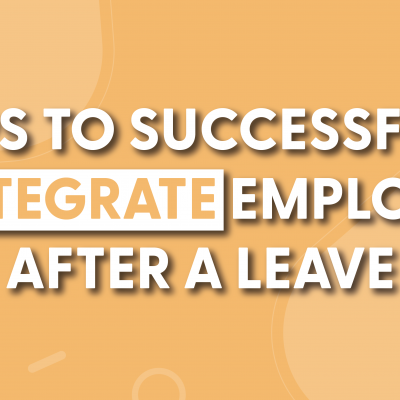You know those viral videos where an athlete is approaching the finish line and, thinking the victory is assuredly in hand, they take their foot off the gas and start celebrating only to get passed up by another competitor right at the very end? (Here’s an example, just in case)
Well, there’s a strong parallel between this scenario and the way in which employees are supported during a leave of absence. HR and People Ops teams move heaven and earth (with how much effort is involved it may feel like you’re literally moving heaven and earth) to support employees when requesting a leave, walking them through all the appropriate steps like applying for state and/or STD benefits if necessary, and answering their questions as they pop up.
And though it may seem like providing such a high level of support means a successfully supported leave is assuredly in hand, if not enough consideration is given to reintegrating employees back into the fold once the leave is over there’s a good chance you’ve celebrated prematurely.
Even the most empathetically supported leave of absence can be ruined at the finish line if the employee returns to work and feels like they’ve been thrown in the deep end without arm floaties.
Below are seven strategies you can implement in your leave of absence process to help ensure that your organization runs through the tape and brings employees back into the workplace feeling supported, engaged, and in a position to succeed.
1. Communicate Openly With Employees Returning From Leave
Open communication is the cornerstone of a successful…everything, and employee reintegration after a leave of absence is no exception. Regularly communicate updates, changes, and expectations to the returning employee so they’re aware of any developments within your organization that may have occurred during their absence.
Actively listen to their concerns (should they have any) and provide a platform for them to express any challenges they might be facing. To do this you’ll need to establish clear channels for communication, such as one-on-one meetings or team discussions, which can help bridge any information gaps and build trust.
The benefits of communicating openly like this are twofold as you’re not only demonstrating your willingness to address any uncertainties they may have, but also you’re facilitating a smoother transition back into their work routine. By maintaining transparent communication, organizations can create a positive and supportive atmosphere that sets the foundation for a successful reintegration process.
2. Prepare a "Welcome Back" Plan For When A Leave of Absence Ends
“Having a re-onboarding plan is very important, especially for those extended leaves when someone has been out for a long time. Just like you would onboard a new hire, have a plan for welcoming employees coming back from leave.” -Kait Feeney, Tilt COO, Mom of 4.
The emotions an employee may feel after a leave of absence can span the gamut. They may feel anxious about changes that have occurred in their absence or catching up on missed work, they may feel nervous that they’re out of the loop on what’s going on, they can be overwhelmed trying to get back up to speed, and they can be some mix of all these.
Help ground your employee’s reintegration experience by providing them with a structured roadmap that can serve as a guide for both them and their team, clearly outlining steps and expectations so everyone is on the same page. Consider including guidelines on implementing a gradual increase in workload to allow the employee to readjust comfortably.
If you have new processes at your organization, incorporate training sessions to familiarize them with any new processes, tools, or changes that occurred during their absence. By setting up a clear schedule for catch-up meetings and check-ins, you’re providing a supportive framework for the returning employee’s transition.
A well-prepared welcome-back plan demonstrates your commitment to the employee’s success and helps them feel more in control of their return to work so that the emotions they’ll be feeling are confident, motivated, and grateful.
3. Assign a Point of Contact When Reintegrating Employees After a Leave
You likely won’t have intimate knowledge of all the goings on within specific teams in departments outside of HR, so assign a dedicated point of contact or mentor to help your team successfully reintegrate an employee after a leave. This designated individual will serve as a go-to resource to the employee, offering support and guidance throughout the return-to-work process should anything be needed.
Not all points of contact or mentors are created equally so make sure they’re well-versed in your company procedures, culture, and any updates that may have occurred. The more you empower the point of contact to provide relevant information to the returning employee, the smoother the reintegration transition becomes.
This one-on-one connection establishes a support system that goes beyond formalities, contributing to the returning employee’s overall engagement and ensuring they have someone to turn to for assistance during their reintegration journey.
4. Reintroduce Employees to the Team After A Leave of Absence
Reintegration through reintroduction is one of the easiest and most effective ways to help an employee returning from leave feel valued and reaffirm their sense of belonging within their team. Organizing a casual reintroduction meeting or team-building activity can go a long way to ensure a positive and welcoming atmosphere for employees returning after time away from work.
Work with their manager to create an event that serves as a venue for the returning employee to reconnect with colleagues and reestablish a sense of camaraderie and support. Provide an opportunity for the returning employee to share their experiences (only if they’re comfortable doing so), updates, and goals, to help improve team understanding and cohesion.
Openly acknowledge their return and celebrate their presence. This intentional effort to reintegrate the employee into the team not only strengthens interpersonal relationships but also helps create a supportive work environment that contributes greatly to the employee’s engagement levels and motivation.
5. Offer Flexible Post-Leave Return-to-Work Arrangements
The needs an employee has when returning to work may vary depending on how long their leave of absence was and what type of leave it was, so honor those diverse needs by providing some flexible arrangements upon their return.
You may consider providing options like adjusted work hours or the ability to work remotely, which can significantly contribute to the smoothness of their transition.
Accommodate any potential challenges the employee may face as they readjust to their professional responsibilities.
Your organization’s willingness to be flexible in this area allows your returning employees to navigate their return with greater ease, which in turn helps establish a positive workplace culture by demonstrating that you value both personal and professional aspects of your employees’ lives.
6. Collect Feedback From Returning Employees
The best way to improve any HR process is to collect information from the source and adjust accordingly. Gain insights into how your employees are responding to your reintegration process by regularly checking in with them to gather feedback on their experience.
This tip is a must in order to continually improve your support plan for employees returning after a leave of absence. Establishing a continuous feedback loop also provides you with an opportunity to address any necessary adjustments that might need prompt attention.
By actively seeking input from your employees as they get reacclimated to work life, you create a collaborative environment that clearly demonstrates you value their perspective and understand the importance of getting this final step in the leave journey correct.
This feedback mechanism should be a two-way street, of course, enabling both you and the employee to share insights, discuss challenges, and identify areas for improvement.
Be prepared as the necessary adjustments based on the feedback you receive may range from providing additional modifications to workload or all the way to potential changes to your policies themselves.
A collaborative, iterative process ensures that your employee’s evolving needs are considered, contributing to a more seamless and tailored reintegration experience. Regular check-ins and a commitment to continuous improvement demonstrate your organization’s dedication to the well-being and success of its returning employees.
7. Employee Assistance Programs for Employees Returning From Leave
Employee Assistance Programs (EAPs) come in all shapes and sizes and vary from organization to organization. They serve as invaluable employee resources for addressing not only work-related challenges but also the personal and emotional aspects of an individual’s life, which is a crucial aspect of supporting employees during their reintegration after a leave of absence.
When an employee returns from a leave of absence, communicate clearly the availability of your EAPs (it’s shocking how many employees don’t know their employers have them), and through your feedback conversations, seek opportunities to expand your EAP offerings where necessary to provide the most comprehensive and supportive environment possible.
If you’re looking to start incorporating EAPs, some you should consider are ones that can provide counseling (say for postpartum depression) or mental health support (for employees returning from a mental health leave, and robust resources to help employees navigate any personal difficulties they may be facing due to the life event that necessitated the leave.
By creating or promoting the use of your EAPs after a leave of absence you help demonstrate your organization’s commitment to the holistic well-being of your employees as they reintegrate into the workforce and beyond.
Support Your Leaves of Absence Through The Reintegration Step
The beginning stages of a leave of absence journey are absolutely critical and for employees can be quite confusing. In some instances, employees need your help just to figure out which way is up, but you can’t let your foot off the support gas pedal once you get their return to work notice.
A leave of absence is only successful when your employee not only returns to work (far from a guarantee if the leave experience wasn’t a positive one) but does so in a way where they feel truly supported, included, and re-engaged in their role.
Run through the leave of absence finish line and implement these tips in your reintegration process to see happier employees in the supportive work culture you’re helping to cultivate.
About Tilt
Tilt is leading the charge in all things leave of absence management through easy-to-use tech and human touch. Since 2017, our proprietary platform and Empathy Warriors have been helping customers make leave not suck by eliminating administrative burdens, keeping companies compliant, and providing a truly positive and supportive leave of absence experience for their people.







